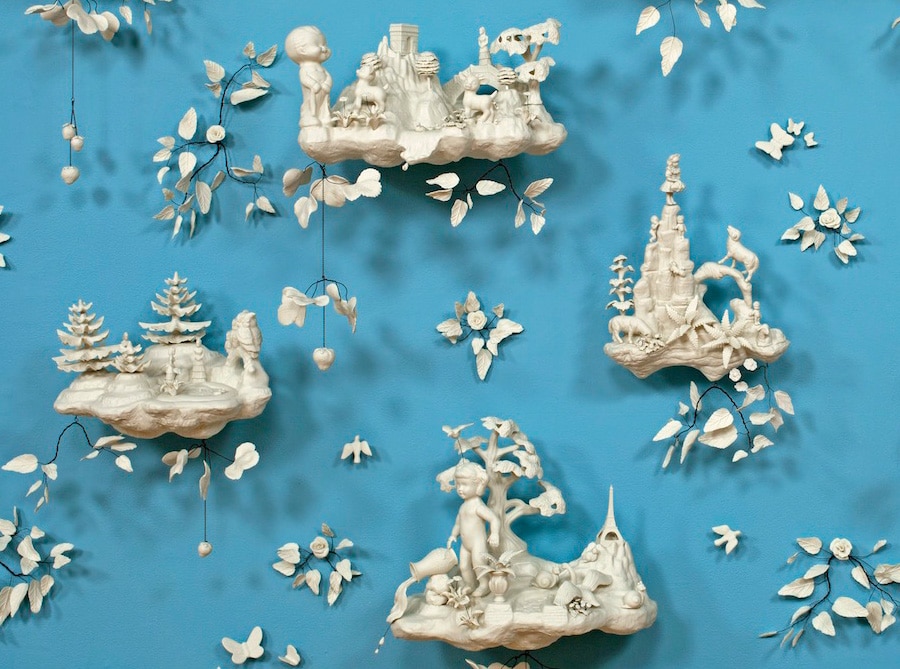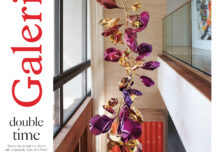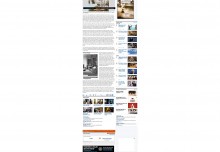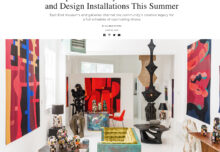Financial Times: How to Spend ItA Great ReliefMay 2013
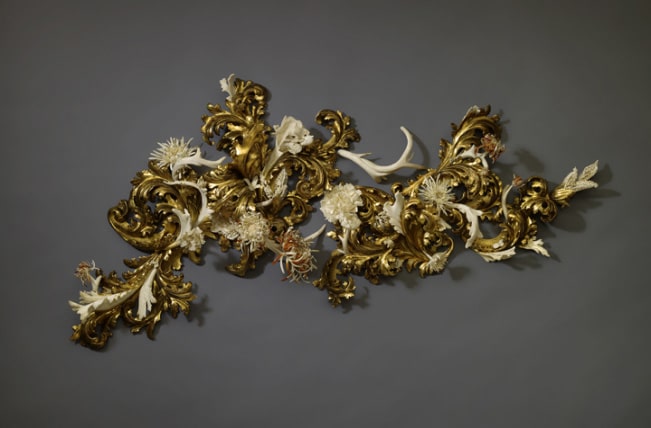
Jennifer Trask, “Burgeon,” USA, 2012, Found 18th & 19th century Italian gilt wood fragments, 22K & 23.5 K gold leaf, antler, bone, teeth (various), epoxy resin.
A GREAT RELIEF
Nicole Swengley reports | May 2013
When New York resident Barbara Tober was looking for a special piece to decorate the sitting room wall of her upstate barn house, she chose Abundant Uselessness, an enchanting and tactile artwork by Jennifer Trask. Highly decorative in style, this unusual wall piece is meticulously handcrafted from found 17th-, 18th- and 19th-century frames, animal bones, teeth and gold leaf. “It’s unbelievably beautiful – just gorgeous,” she says.
Like other contemporary homeowners, Tober has discovered that sculptural, 3D wall art has the power to quicken the senses and add visual excitement to a space. As a former chairman of the Board of Trustees of New York’s Museum of Arts and Design, she initially encountered Trask’s work at the museum’s Dead or Alive show in 2010 and couldn’t resist buying a piece from the limited-edition series for herself. “We acquired a large one for the museum and I bought a smaller one for my own home,” she says. “It’s a fascinating work, with elements of nature, of deconstruction, of things dying and being reborn. It has dimension, life, brilliance – and it makes me happy to look at it.”
Sculptural wall art is not, of course, a new concept. Interior designers and architects have been using eye‑catching pieces in public spaces and hotel lobbies for a while. What’s different now is that large-scale, 3D work is being bought to decorate residential interiors, too. “Clients love living with these pieces,” says Todd Merrill, owner of the eponymous, New York-based gallery that represents Trask, whose Vestige series includes the 3m-long Burgeon ($175,000, second picture) made of found 18th- and 19th-century Italian giltwood fragments alongside antlers, bones and teeth. “This type of work is emerging as the boundaries between craft, design and fine art blur. It is being made by artists who have hands-on ‘craft’ ability at a very high level, but are using their medium of choice – wood, clay or bone – to express a complex narrative or a free‑flowing design. It is appreciated by clients on many levels, from the handiwork to the concept.”
Valerio Capo, co-founder of London’s Gallery Fumi, has also noted increasing interest in large-scale sculptural work for residential use. “People want to live with something tactile on their walls,” he says. “They are looking for something different and they’re drawn to unusual materials because they like to engage with the work.” He cites Pithvava, a looping, 3m-wide wall sculpture made from dentalium shells by Royal College of Art graduate Rowan Mersh. It takes around three months for Mersh to fix 65,000 individual shells into an intricate pattern, and clients clearly appreciate the time, skill and artistry involved in each unique piece (£10,000 to £30,000). His work graces the long hallway of a St Moritz residence, a music producer’s home studio in Montreal, a home spa in Moscow and a Dubai villa.
“I’m interested in materials that can be repeated and multiplied to create textural patterns that begin to look like something else,” says Mersh. “The placing of the shells is very methodical and specific. This gives the material a voice and character. The animation makes it work.” Now he is crafting artworks from hundreds of walnut shells, which were recently shown at Pavilion of Art & Design in Paris and are as textural and intriguing as his seashell designs.
The power of repetition seems particularly potent when the artful components are surprisingly commonplace. Colombian-born Federico Uribe, who is now based in Miami, is a conceptual artist who sculpts and weaves together everyday objects to create intricate and unpredictable pieces, such as Cloud (£9,000, sixth picture) made from safety pins. Anything from wooden paintbrush handles, pencils, books and coins to domino tiles, metal hangers, vinyl records, gardening tools, shoes and shoe laces find their way into his work, transformed in a repetitive and painstaking process into captivating sculptures with depths of meaning far removed from the original materials.
“Familiar objects are easier to communicate with, as they are a language people understand,” says Per Emanuelsson who, with Bastian Bischoff, founded the design studio Humans Since 1982 five years ago (the name refers to their birth year). They call their work “functional art”, although any quasi-practical aspects are transcended by its visual allure. At Design Days Dubai last month, visitors stood transfixed by a wall installation comprising 288 clocks (about €275,000), an evolution of an earlier work called Clock Clock (from €22,000, fourth picture) – a monochrome wall of 24 analogue alarm clocks. The positioning of the hands of six clocks together forms a number and all 24 create a single giant display similar to a digital watch. Every minute each clock revolves, before settling to reveal the updated time. It’s a masterwork of mechanical choreography.
For their latest limited editions, the Swedish duo filled wall cabinets with 300 tiny, sparkling LED lights (€6,600), which look like dazzling displays of fireflies. Each individual bulb is labelled with its name, size and colour temperature, as if a specimen. The artists’ stated aim is to emulate a scientific collection and, indeed, smaller versions with 70 LEDs (€2,200) or 120 LEDs (€3,300) are mounted in 70-year-old insect-collection drawers from Stockholm’s Museum of Natural History. These are desirable artworks and not lifeless museum exhibits, however, and the overall effect is enchanting.
“Clients buy 3D wall pieces not so much as an alternative to their collections of paintings or photographs, but rather as their sculptural peers,” says Maria Wettergren of the eponymous, Paris-based gallery representing Danish designer Astrid Krogh. The gently colour-changing optical fibres in Krogh’s limited-edition wall piece Mare Tranquillitatis (€18,000) evoke a contemplative mood, while the neon tubes in Five‑Fold Happiness (€12,000, fifth picture) turn a Chinese symbol into a big, dreamy cloud.
“I think people enjoy the physical experience of 3D art,” says New York-based artist Darcy Miro. “There is interaction with the work – approaching it from different angles, looking through it, or maybe lighting it from behind – which often leads to a more intimate experience. To have a sculpture on a wall is still unexpected and appreciated by those open to exploring the different planes of space.”
Miro’s own work is bold and innovative. She hammers shapes cut from solid-copper sheets, then patinates the surfaces in shades of green. Back-lit, these individually hung Wall Scales ($23,750 for a 72sq ft installation) take on the dramatic appearance of gleaming scarabs. Spear, meanwhile, comprises small, white-bronze elements, repeated to form 3D “wallpaper” ($900 per sq ft) and sized to fit specific spaces. “People have used it conventionally on walls and in more curious ways, as a geometric shape that runs up corners, for example,” she says.
Walls do, of course, offer a sizeable canvas for striking shapes and imagery, such as Patricia Urquiola’s limited-edition, giant Stars (price on request, example seen in third picture), created from folded cardboard, or New York-based Japanese sculptor Shizue Imai’s Constellation (€80,000), a supercharged starburst handmade in ceramic with a metal glaze.
Equally arresting are the explosive arabesques of Sèvres‑trained Alice Riehl, captured by immersing lace in porcelain to create an innovative new material. “I wanted to turn porcelain – a still material – into something in motion,” says the Paris-based designer. “There are several ways to combine the materials – you can print lace on porcelain or soak it into the clay, but what really matters to me is paying homage to the creativity of women whose needlework, knitting and threads act as a link through generations.” Clients are enamoured with the results. Riehl recently created two wall pieces with swirling orchid shapes for the living room of a client’s newly built apartment in Singapore. And interior designer Jean-Philippe Nuel commissioned an artwork for the Intercontinental hotel, which opens in a listed 18th-century building in Marseilles this month. Riehl’s underwater-inspired, 3m-wide lobby installations can be rescaled for residential commissions (from €5,000).
London-based ceramicist Barnaby Barford takes a more confrontational approach. Since mirrors are incorporated into his Seven Deadly Sins series of large‑scale wall sculptures (prices on request) onlookers find that they are part of the piece. “Ceramic is relatively unexplored in contemporary art. People don’t expect to be challenged by it, and I wanted people to be ‘within’ the artwork itself,” says Barford. Still, these designs are decorative over functional and, says gallerist David Gill, “super-serious in intent”.
To explore the concept of sin, Barford’s mirrors are each framed with innocent-looking clusters of ceramic flowers and foliage. However, these are loaded with subversive messages – from takeaway menus (Gluttony) to the faces of porn stars (Lust) and photographs of the London 2011 riots (Envy). Avarice is crafted from 9,000 handmade porcelain flowers and leaves depicting fragments of paper currency. Each design makes you stop and look twice. There’s no doubt that many people are keen to live with such dynamic and challenging pieces. “In a London home, Avarice hangs on the wall at the turn of a staircase and it looks fabulous there,” says Barford.
A serious underlying narrative similarly pervades the work of Chinese designer Danful Yang. Her porcelain wall sculpture, Devil or Angel (price on request, first picture), comprises broken or disfigured infants within open steel tubes. These fragile figures are reminders that the fate of the earth is in our hands. “I wanted to show that how we treat our planet will affect babies – they are our future, and this is what they will become,” she says.
This narrative approach to wall art is employed to spectacular effect by New York-based Beth Katleman. Folly ($225,000, seventh picture) is a limited‑edition handmade installation measuring 3m by 5.5m, with more than 3,000 individual pieces mounted on a painted wall. On one level, it’s a 3D homage to toile wallpaper and, at first sight, its rococo elements and frolicking figures appear playful and benign. Look closer, though, and it’s clear that they are imbued with a darker mood. “My sculptures examine the nature of consumption and desire in our time,” says Katleman, who creates her subversive scenarios from kitsch objects and vintage toys cast in porcelain.
“Folly is a still life, yet it is animated and belongs not to the age of enlightenment or romanticism, but to the age of film and the internet,” adds Todd Merrill, who has sold the artwork to private collectors in Korea, Hong Kong and Sydney. For smaller-scale settings, there is an edition of half sizes ($125,000), with one already snapped up by New York decorator Peter Marino for Dior’s new Hong Kong flagship. “Toile de Jouy was a favourite of Dior’s and I thought this was a modern and quirky interpretation of that,” says Marino. It goes to show that sculptural wall art is, perhaps, the glamorous New Look for which we’ve all been waiting.
Alice Riehl, 33 Rue Planchat, 75020 Paris (+336-0943 0851; www.aliceriehl.com). Astrid Krogh, www.astridkrogh.com and see Galerie Maria Wettergren. Barnaby Barford, www.barnabybarford.co.uk and see David Gill Galleries. Bespoke Global, +1212-537 0112; www.bespokeglobal.com. Beth Katleman, www.bethkatleman.com and see Todd Merrill Studio Contemporary. Chahan Gallery, 11 Rue de Lille, 75007 Paris (+331-4703 4700; www.chahan.com). Danful Yang, www.danfulyang.com and see Pearl Lam Fine Art. Darcy Miro, www.darcymiro.com and see Bespoke Global. David Gill Galleries, 2-4 King Street, London SW1 (020-3195 6600; www.davidgillgalleries.com). Federico Uribe, www.federicouribe.com and see Gallery Fumi. Galerie Maria Wettergren, 18 Rue Guénégaud, 75006 Paris (+331-4329 1960; www.mariawettergren.com). Gallery Fumi, 16 Hoxton Square, London N1 (020-7410 2366; www.galleryfumi.com). Humans Since 1982, www.humanssince1982.com and see Victor Hunt. Jennifer Trask, www.jennifertrask.com and see Todd Merrill Studio Contemporary. Nilufar, Via della Spiga 30, 20121 Milan (+392‑780 193; www.nilufar.com). Patricia Urquiola, www.patriciaurquiola.com and see Nilufar. Pearl Lam Fine Art, 181 Middle Jiangxi Road G/F, Shanghai 200002 (+8621- 6323 1989; www.pearllam.com). Rowan Mersh, www.rowanmersh.com and see Gallery Fumi. Shizue Imai, www.cocobolodesign.com and see Chahan Gallery. Todd Merrill Studio Contemporary, 65 Bleecker Street, New York, NY 10012 (+1212-673 0531; www.merrillantiques.com). Victor Hunt, 16 Lambert Crickx, 1070 Brussels (+322-78 79 957; www.victor-hunt.com) and branch.
Todd Merrill Studio
80 Lafayette Street
New York NY 10013
Phone: 212 673 0531
80 Lafayette Street
New York NY 10013
Phone: 212 673 0531
Website: www.ToddMerrillStudio.com
E-mail: info@ToddMerrillStudio.com
Instagram: @ToddMerrillStudio
E-mail: info@ToddMerrillStudio.com
Instagram: @ToddMerrillStudio
Todd Merrill Summer Studio
11 South Main Street
Southampton, NY 11968
Phone: 631 259 3601
11 South Main Street
Southampton, NY 11968
Phone: 631 259 3601


